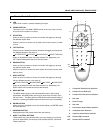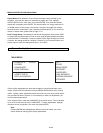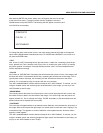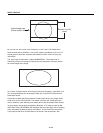
11-13
QUICK SET-UP GUIDE
Overall Functional Description
The VHD-Controller’s purpose is twofold. First, it provides aspect ratio control for
the projectors, and can do so on either a WIDESCREEN or a standard 4:3 screen.
Second, it provides a clean, progressive signal to the projector.
The processing the controller uses is called SCALING. Scaling is simply a way of
taking a signal, ‘digitizing’ it, then converting it to any of a number of resolutions. It
is by manipulating the algorithms of the scaling process that we are able to not only
produce properly-configured aspect ratios, but to match the resolutions required for
the projector it will be used with.
An INTERLACED signal is the type of signal that comes from all consumer sources
(with the exception of DTV decoders and computers). DVD players, Laser Disc
players, and VCRs are all examples of source equipment that have interlaced out-
puts. An interlaced signal is simply described as this:
An NTSC picture is made of approximately 480 lines. Images are drawn 60 times a sec-
ond, but in an interlaced system, only half the lines are drawn each ‘pass’. Therefore, it
240 lines (even)
Second 1/60th of a second
240 lines (odd)
First 1/60th of a second
takes two ‘passes’ to actually complete the picture. On the first 1/60
th
of a second, all of
the ‘ODD’ lines are drawn, then the ‘EVEN’ lines the next 1/60
th
of a second. This is also
called ‘480i’, where 480 is the total number of lines of resolution, and ‘i’ means interlaced.
A PROGRESSIVE signal, however, draws all 480 lines each 1/60
th
of a second, not
half and half like an interlaced signal. A ‘line doubler’, for example, outputs a 480-line
progressive signal (also known as 480P). The line doubler takes the first field (odd
lines), and stores them in memory, then takes the second field (even lines) and does
the same. Then, all 480 are output at once, and then the same frame is repeated.
The controller starts off as a line doubler by ‘de-interlacing’ the signal. Then, the
480p signal is scaled to appropriate resolution, and then output to the projector. It is
Runco’s high-quality scaling process as well as its de-interlacing that provides the
clean, resolved image that you see from your projector. It is also how the controller
can provide aspect ratio control.
In the next chapter, the individual menu items will be described in detail. Overall,
the controller has a number of useful functions aside from the scaling and de-inter-
lacing described above. It has typical picture controls, including COLOR (satura-
tion), TINT (hue), BRIGHTNESS (black level), SHARPNESS, CONTRAST (ratio of
white to black) and other picture enhancements such as LUMA and CHROMA
ENHANCE.


















